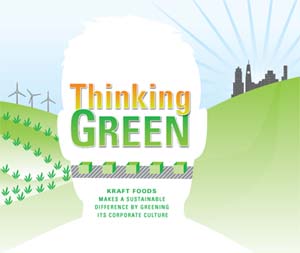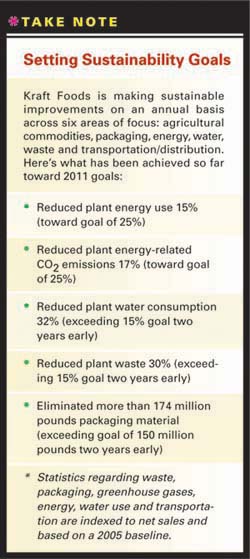Kraft Thinks Green

Being green isn't new to Kraft Foods (www.kraftfoodscompany.com), but senior leadership raised the bar significantly in the last three years, making sustainability a company-wide effort and setting aggressive goals.
Today, sustainability is part of every business decision made at Kraft Foods in its noble effort to meet the needs of the present while being mindful of the future. This philosophy is behind the launch of several innovative programs that are yielding impressive results when it comes to the company's eco-footprint. In fact, Kraft Foods has already exceeded some of its aggressive sustainability goals in six focus areas (see Take Note: Setting Sustainability Goals on Page 10). The key is to get everyone -- from the most senior levels down -- on the same "green-focused" page.
"We're changing our behavior and business practices, and as a result, we're changing the culture," says Steve Yucknut, vice president, Sustainability, Kraft Foods. "Sustainability is now a priority across our organization, including but not limited to, general management, marketing, operations, and research and development (R&D)."
A lean core team, lead by Yucknut, provides strategic direction from the center of the company. Ultimately, however, it's up to business unit leaders to decide and execute specific projects that impact their businesses.
 But these leaders aren't the only ones held accountable for sustainability at Kraft Foods. All employees are challenged to generate ideas that help grow the company's business and reduce costs, while protecting the environment and society.
But these leaders aren't the only ones held accountable for sustainability at Kraft Foods. All employees are challenged to generate ideas that help grow the company's business and reduce costs, while protecting the environment and society.
"We're fostering empowerment at the grass roots level," says Yucknut. And these efforts clearly signal a culture change as employees are embracing the company's commitment to environmental sustainability in new ways.
"Once sustainability is part of the business goals and no longer the role of a select few in the center, you'll see a whole new level of commitment and creativity in ways to drive growth and shareholder value," says Yucknut.
Many of Kraft Foods' locations around the world have "Green Teams", employee-led volunteer groups that work to integrate sustainability into daily operations at local offices or manufacturing facilities. While each team is autonomous, they connect through a dedicated Web site that lets them share ideas. When one employee in Canada set up a bin at his plant for battery recycling, he collected more than one million pounds in the first year. And the idea is now being replicated in other locations.
"Today, our biggest challenge is keeping up with the demand from enthusiastic employees and business teams," says Yucknut. "It shows our employees are feeling empowered to make a difference."
And what a difference it is. Here, Yucknut shares the company's biggest sustainability success stories in four key areas, all of which have been made possible in part by a "greener" corporate culture.
Success Story #1
Packaging
Kraft Foods not only achieved but exceeded an ambitious goal to eliminate 150 million pounds of packaging material from its supply by 2011. "At the end of 2009, we took 174 million pounds out," reports Yucknut.
How did Kraft Foods do this? By leveraging the thought leadership and knowledgeable skills of the global packaging community.
"Taking out 174 million pounds of packaging was no easy task. It was the summation of more than 250 individual projects executed across the globe," says Yucknut.
The collective effort is made possible, in part, by the existence of a global collaborative network of sustainability leaders in R&D that meets regularly to bounce ideas off each other and share best practices.
It's also made possible by the use of an innovative in-house tool called the Packaging Eco-Calculator, which enables packaging developers worldwide to positively affect the environmental impact of the packaging systems they create.
Based on data from the U.S. Environmental Protection Agency, the U.S. Department of Energy and industry groups, the tool looks at the environmental impact of new package designs. It measures information, like the total amount of packaging used; how much post-consumer material can be used; energy used to create the packaging; amount of CO2 generated as the materials are created; and so on.
"We first developed the Eco-Calculator in Europe several years ago, and now we've rolled it out globally to our packaging teams," says Yucknut. "Since each new design goes through the Eco-Calculator, it helps us continually look for new opportunities."
Eco-friendly packaging design successes include:
- The Oscar Mayer Deli Creations packaging in the United States, using 30 percent less paperboard than the previous design. It's expected to keep 1.2 million pounds of packaging out of landfills. "Consumers like the new package better because it is smaller and easier to pack and take to work," reports Yucknut.
- The redesigned Crystal Light powdered beverage packaging, using nearly 10 percent less material per package and 25 percent less material in shipping trays. That eliminates 250 tons of packaging per year and means Kraft Foods can fit 33 percent more packages per pallet, meaning fewer trucks on the road.
- Kraft Real Mayo has 20 percent less packaging than before. The design also eliminates 1.3 million pounds of materials per year and lets Kraft Foods ship 10 percent more product per truckload.
Waste
Waste is a relative term. What is waste to one person is a valuable commodity to another. Waste has to be dealt with in a systematic basis. Each component needs to be analyzed for potential value. Today, Kraft Foods recycles nearly 90 percent of its global manufacturing waste.
"We're looking to reduce the amount of waste we produce and find value in what we do create," says Yucknut. "That means turning waste into energy and finding partners across the supply chain that can put waste to work."
In the United States, Kraft Foods partners with Sonoco (www.sonoco.com), a global provider of packaging products and services, on plant waste reduction across North America, resulting in a number of plants that operate as "zero waste to landfill".
The company is taking the same approach to help consumers deal with packaging that isn't recyclable. In 2008, Kraft Foods and its Capri Sun brand started partnering with TerraCycle (www.terracycle.net), an innovative company that reuses product packaging to make new, useful products.
Today, Kraft Foods is the largest sponsor of TerraCycle "brigades" -- or collection points -- with more than 30,000 locations and nearly seven million people signed up to collect waste across the United States. The program has been so successful that it's expanded internationally to the United Kingdom, Canada, Mexico and Brazil, and there's more in the works.
Success Story #3
Agricultural Commodities
For example, in 2003, Kraft Foods started collaborating with the Rainforest Alliance (www.rainforest-alliance.org), an international nonprofit organization dedicated to the conservation of tropical forests.
"They weren't the biggest name around, but they had the knowledge and the people in the field to help ensure we'd have a high quality supply of coffee and cocoa for years to come," says Yucknut. "And over the years, we've built scale and competitive advantage."
By 2009, Kraft Foods became the largest buyer of coffee and cocoa from Rainforest Alliance Certified farms, purchasing more than 34,000 metric tons of coffee and 7,100 metric tons of cocoa. What's more, in the last six years, Kraft Foods' collaboration with the Rainforest Alliance for coffee has benefited more than 300,000 farm workers and their dependents on more than 60,000 hectares of farmland in tropical countries. And for cocoa, the collaboration has benefited 27,500 members of farming families on more than 16,000 hectares under sustainable production.
"Sustainability is a journey and that is particularly true when it comes to increasing the sustainable nature of our agricultural commodities," admits Yucknut. "Investments in sustainable agriculture take time to mature. Changing behaviors and procedures at the farm level requires perseverance and patience. And most importantly, it takes a long term commitment from the business teams making the upfront investments for down the road payback. In the world of 'what have you done for me lately?' and 'how did you do last quarter?', that is not something to be taken lightly."
Success Story #4
Greener Offices
The company's Northfield, Ill. headquarters recently became ENERGY STAR qualified by the U.S. Environmental Protection Agency. It's in the top 8 percent of commercial buildings in the country for energy efficiency and uses 33 percent less energy than similar commercial buildings. That means it's less expensive to operate and emits fewer greenhouse gases than its peers.
The campus is surrounded by green space and walking trails for employees, and three lakes on site capture rainwater for reuse to handle half of the property's irrigation needs. The building is even cooled by ice.
Want to know more? Visit www.kraftfoodsbetterworld.com.
